部分倒装与完全倒装的区别
英语完全倒装和部分倒装解决不易懂
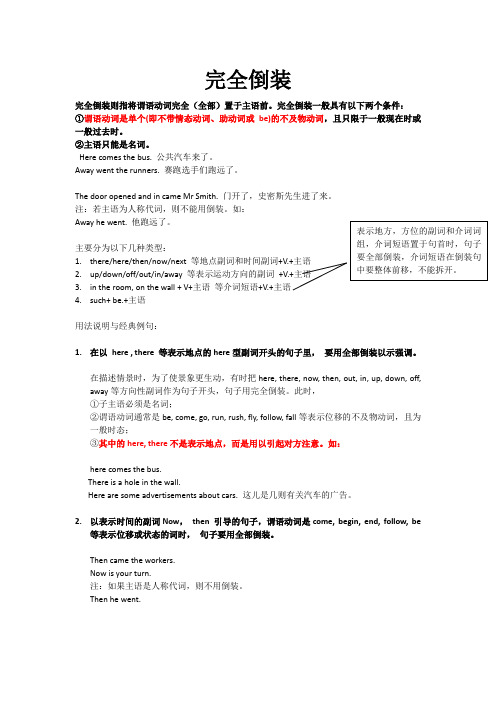
完全倒装完全倒装则指将谓语动词完全(全部)置于主语前。
完全倒装一般具有以下两个条件:①谓语动词是单个(即不带情态动词、助动词或be)的不及物动词,且只限于一般现在时或一般过去时。
②主语只能是名词。
Here comes the bus. 公共汽车来了。
Away went the runners. 赛跑选手们跑远了。
The door opened and in came Mr Smith. 门开了,史密斯先生进了来。
注:若主语为人称代词,则不能用倒装。
如:Away he went. 他跑远了。
主要分为以下几种类型:1.there/here/then/now/next 等地点副词和时间副词+V.+主语2.up/down/off/out/in/away 等表示运动方向的副词+V.+主语3.in the room, on the wall + V+主语等介词短语+V.+主语4.such+ be.+主语用法说明与经典例句:1.在以here , there 等表示地点的here型副词开头的句子里,要用全部倒装以示强调。
在描述情景时,为了使景象更生动,有时把here, there, now, then, out, in, up, down, off, away等方向性副词作为句子开头,句子用完全倒装。
此时,①子主语必须是名词;②谓语动词通常是be, come, go, run, rush, fly, follow, fall等表示位移的不及物动词,且为一般时态;③其中的here, there不是表示地点,而是用以引起对方注意。
如:here comes the bus.There is a hole in the wall.Here are some advertisements about cars. 这儿是几则有关汽车的广告。
2.以表示时间的副词Now,then 引导的句子,谓语动词是come, begin, end, follow, be等表示位移或状态的词时,句子要用全部倒装。
英语中的完全倒装和局部倒装
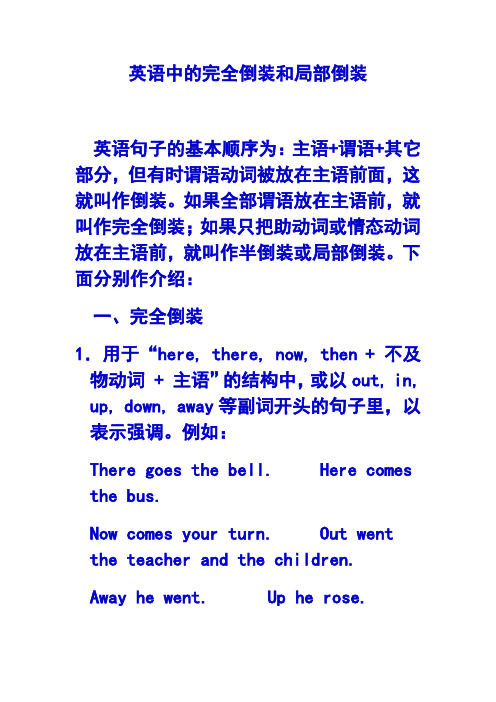
英语中的完全倒装和局部倒装英语句子的基本顺序为:主语+谓语+其它部分,但有时谓语动词被放在主语前面,这就叫作倒装。
如果全部谓语放在主语前,就叫作完全倒装;如果只把助动词或情态动词放在主语前,就叫作半倒装或局部倒装。
下面分别作介绍:一、完全倒装1.用于“here, there, now, then + 不及物动词 + 主语”的结构中,或以out, in, up, down, away等副词开头的句子里,以表示强调。
例如:There goes the bell. Here comes the bus.Now comes your turn. Out went the teacher and the children.Away he went. Up he rose.2.用于“there be”的结构中,例如:There were many boys and girls on the playground just now.There will be a new station near our school.3.当介词短语或地点状语放在句首作状语时,例如:North of the city lies/is a new airport.From the valley came a frightening sound with some cries.4.表语放句首时倒装结构为:“表语+连系动词+主语”,例如:Present at the meeting is our English teacher.Gone are the days when we had a good time at the mountain village.In the middle of the room stand twodesks and some chairs for the party.5.当“so/such… that”结构中的so或such 位于句首时,例如:So beautiful was she that many men would like to dance with her at the party.Such an honest boy is he that he gave back the change to me after shopping.6.用于so, nor, neither开头的句子,表示重复前面的内容,原句的谓语应与前面的谓语动词的时态、形式等相一致。
【英语知识点】部分倒装与完全倒装的区别
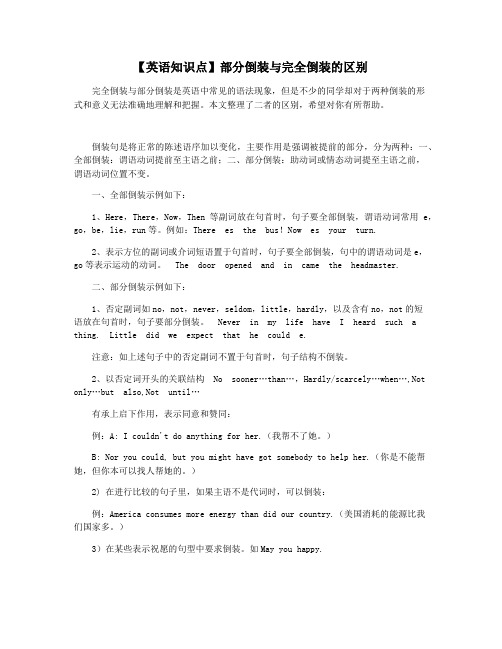
【英语知识点】部分倒装与完全倒装的区别完全倒装与部分倒装是英语中常见的语法现象,但是不少的同学却对于两种倒装的形式和意义无法准确地理解和把握。
本文整理了二者的区别,希望对你有所帮助。
倒装句是将正常的陈述语序加以变化,主要作用是强调被提前的部分,分为两种:一、全部倒装:谓语动词提前至主语之前;二、部分倒装:助动词或情态动词提至主语之前,谓语动词位置不变。
一、全部倒装示例如下:1、Here,There,Now,Then等副词放在句首时,句子要全部倒装,谓语动词常用e,go,be,lie,run等。
例如:There es the bus!Now es your turn.2、表示方位的副词或介词短语置于句首时,句子要全部倒装,句中的谓语动词是e,go等表示运动的动词。
The door opened and in came the headmaster.二、部分倒装示例如下:1、否定副词如no,not,never,seldom,little,hardly,以及含有no,not的短语放在句首时,句子要部分倒装。
Never in my life have I heard such a thing. Little did we expect that he could e.注意:如上述句子中的否定副词不置于句首时,句子结构不倒装。
2、以否定词开头的关联结构No sooner…than…,Hardly/scarcely…when…,Not only…but also,Not until…有承上启下作用,表示同意和赞同:例:A: I couldn't do anything for her.(我帮不了她。
)B: Nor you could, but you might have got somebody to help her.(你是不能帮她,但你本可以找人帮她的。
)2) 在进行比较的句子里,如果主语不是代词时,可以倒装:例:America consumes more energy than did our country.(美国消耗的能源比我们国家多。
全部倒装和部分倒装的区别有哪些怎样区分
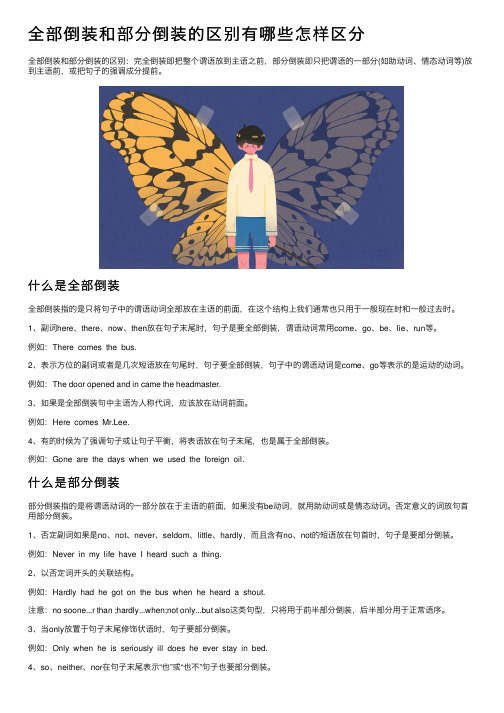
全部倒装和部分倒装的区别有哪些怎样区分全部倒装和部分倒装的区别:完全倒装即把整个谓语放到主语之前,部分倒装即只把谓语的⼀部分(如助动词、情态动词等)放到主语前,或把句⼦的强调成分提前。
什么是全部倒装全部倒装指的是只将句⼦中的谓语动词全部放在主语的前⾯,在这个结构上我们通常也只⽤于⼀般现在时和⼀般过去时。
1、副词here、there、now、then放在句⼦末尾时,句⼦是要全部倒装,谓语动词常⽤come、go、be、lie、run等。
例如:There comes the bus.2、表⽰⽅位的副词或者是⼏次短语放在句尾时,句⼦要全部倒装,句⼦中的谓语动词是come、go等表⽰的是运动的动词。
例如:The door opened and in came the headmaster.3、如果是全部倒装句中主语为⼈称代词,应该放在动词前⾯。
例如:Here comes Mr.Lee. 4、有的时候为了强调句⼦或让句⼦平衡,将表语放在句⼦末尾,也是属于全部倒装。
例如:Gone are the days when we used the foreign oil. 什么是部分倒装部分倒装指的是将谓语动词的⼀部分放在于主语的前⾯,如果没有be动词,就⽤助动词或是情态动词。
否定意义的词放句⾸⽤部分倒装。
1、否定副词如果是no、not、never、seldom、little、hardly,⽽且含有no、not的短语放在句⾸时,句⼦是要部分倒装。
例如:Never in my life have I heard such a thing.2、以否定词开头的关联结构。
例如:Hardly had he got on the bus when he heard a shout. 注意:no soone...r than ;hardly...when;not only...but also这类句型,只将⽤于前半部分倒装,后半部分⽤于正常语序。
倒装句可分为全部倒装和部分倒装
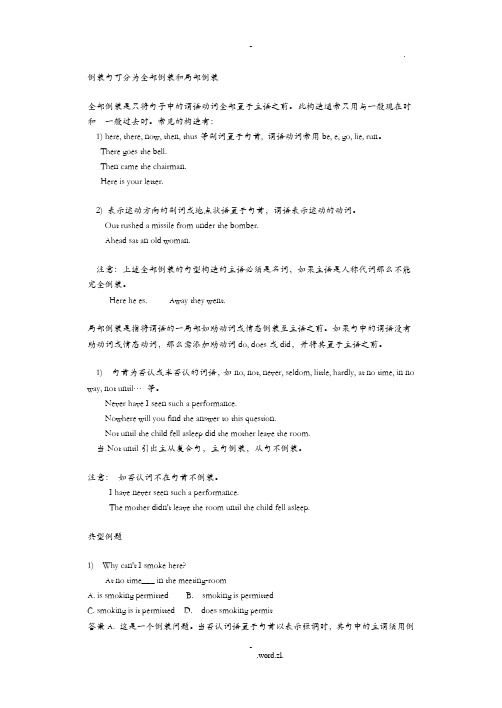
倒装句可分为全部倒装和局部倒装全部倒装是只将句子中的谓语动词全部置于主语之前。
此构造通常只用与一般现在时和一般过去时。
常见的构造有:1) here, there, now, then, thus等副词置于句首, 谓语动词常用be, e, go, lie, run。
There goes the bell.Then came the chairman.Here is your letter.2) 表示运动方向的副词或地点状语置于句首,谓语表示运动的动词。
Out rushed a missile from under the bomber.Ahead sat an old woman.注意:上述全部倒装的句型构造的主语必须是名词,如果主语是人称代词那么不能完全倒装。
Here he es. Away they went.局部倒装是指将谓语的一局部如助动词或情态倒装至主语之前。
如果句中的谓语没有助动词或情态动词,那么需添加助动词do, does或did,并将其置于主语之前。
1) 句首为否认或半否认的词语,如no, not, never, seldom, little, hardly, at no time, in no way, not until… 等。
Never have I seen such a performance.Nowhere will you find the answer to this question.Not until the child fell asleep did the mother leave the room.当Not until引出主从复合句,主句倒装,从句不倒装。
注意:如否认词不在句首不倒装。
I have never seen such a performance.The mother didn't leave the room until the child fell asleep.典型例题1) Why can't I smoke here?At no time___ in the meeting-roomA. is smoking permittedB. smoking is permittedC. smoking is it permittedD. does smoking permit答案A. 这是一个倒装问题。
英语全部倒装与部分倒装区别讲解 多种比对

全部倒装与部分倒装区别英语句子一般主语在前,谓语在后,但有时因为语法结构的要求或由于修辞的要求,要改变句子的自然语序,把一些本应置于主语之后的成分提前,我们称这种语序为倒装语序。
解释1:部分倒装—是指将谓语的一部分如系动词,助动词或情态动词倒装至主语之前。
如果句子的谓语没有助动词或情态动词,则需添加助动词do, does或did,并将其置于主语之前。
解释2:完全倒装即把整个谓语放到主语之前In came the teacher and the class began. (老师走了进来,然后开始上课。
)部分倒装即只把谓语的一部分(如助动词、情态动词等)放到主语前,或把句子的强调成分提前。
Nor did he let the disease stop him from living the kind of life he has always dreamt about(疾病没有使他放弃过上梦想中的生活)解释3:为了表示强调,经常将never等否定副词或by no means等杏定词组放在句首,此时句子要求将系动词、助动词或情态动词放在主语之前,而谓语部分位置不变,这就是部分倒装。
Not until yesterday did little John change his mind.直到昨天小约翰才改变主意。
完全倒装是主语和谓语完全颠倒。
如;Here comes the bus. 公共汽车来了。
There goes the bell. 铃响了。
解释4:英语句子的自然语序是“主语+ 谓语”。
如果将谓语的全部或一部分放在主语之前,这种语序被称为“倒装”。
谓语全部放在主语之前,为全部倒装;只把助动词,连系动词或情态动词放在主语之前,为部分倒装。
倒装的原因,一是语法结构的需要(如某些疑问句);二是为了强调;三是保持句子的平衡或是上下文紧密相接解释5:英语句子的结构一般是“主语+ 谓语”,语法上称这种语序为自然语序。
倒 装 句
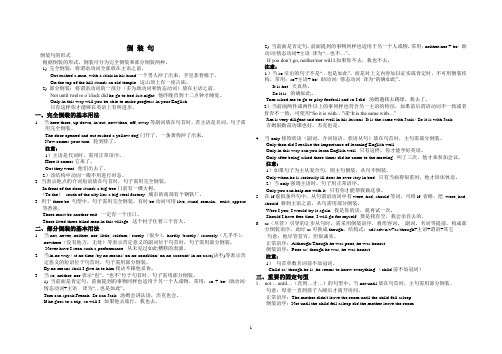
倒装句倒装句的形式根据倒装的形式,倒装可分为完全倒装和部分倒装两种。
1) 完全倒装:将谓语动词全部放在主语之前。
Out rushed a man, with a stick in his hand.一个男人冲了出来,手里拿着棍子。
On the top of the hill stands an old temple. 这山顶上有一座古庙。
2) 部分倒装:将谓语动词的一部分(多为助动词和情态动词)放在主语之前。
Not until twelve o’clock did he go to bed last night. 他昨晚直到十二点钟才睡觉。
Only in this way will you be able to make progress in your English.只有这样你才能够在英语上有所进步。
一、完全倒装的基本用法1. 当here/there, up/down, in/out, now/then, off, away等副词放在句首时,若主语是名词,句子需用完全倒装。
The door opened and out rushed a yellow dog.门开了,一条黄狗冲了出来。
Now comes your turn. 轮到你了。
注意:1)主语是代词时,需用正常语序。
Here it comes.它来了。
Out they went. 他们出去了。
2)该结构中动词一般不用进行时态。
2. 当表示地点的介词短语放在句首时,句子需用完全倒装。
In front of the door stands a big tree.门前有一棵大树。
(To the)south of the city lies a big steel factory. 城市的南部有个钢铁厂。
3. 用于there be 句型中,句子需用完全倒装。
有时be动词可用live, stand, remain,exist, appear等替换。
部分倒装和完全倒装的区别
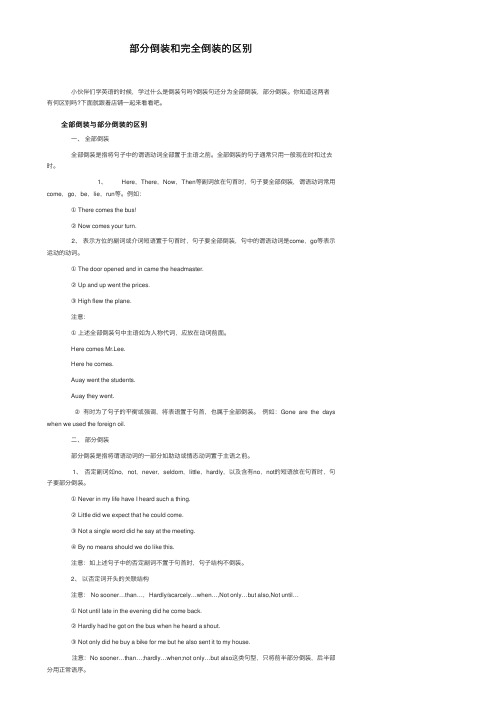
部分倒装和完全倒装的区别 ⼩伙伴们学英语的时候,学过什么是倒装句吗?倒装句还分为全部倒装,部分倒装。
你知道这两者有何区别吗?下⾯就跟着店铺⼀起来看看吧。
全部倒装与部分倒装的区别 ⼀、全部倒装 全部倒装是指将句⼦中的谓语动词全部置于主语之前。
全部倒装的句⼦通常只⽤⼀般现在时和过去时。
1、Here,There,Now,Then等副词放在句⾸时,句⼦要全部倒装,谓语动词常⽤come,go,be,lie,run等。
例如: ① There comes the bus! ② Now comes your turn. 2、表⽰⽅位的副词或介词短语置于句⾸时,句⼦要全部倒装,句中的谓语动词是come,go等表⽰运动的动词。
① The door opened and in came the headmaster. ② Up and up went the prices. ③ High flew the plane. 注意: ①上述全部倒装句中主语如为⼈称代词,应放在动词前⾯。
Here comes Mr.Lee. Here he comes. Auay went the students. Auay they went. ②有时为了句⼦的平衡或强调,将表语置于句⾸,也属于全部倒装。
例如:Gone are the days when we used the foreign oil. ⼆、部分倒装 部分倒装是指将谓语动词的⼀部分如助动或情态动词置于主语之前。
1、否定副词如no,not,never,seldom,little,hardly,以及含有no,not的短语放在句⾸时,句⼦要部分倒装。
① Never in my life have I heard such a thing. ② Little did we expect that he could come. ③ Not a single word did he say at the meeting. ④ By no means should we do like this. 注意:如上述句⼦中的否定副词不置于句⾸时,句⼦结构不倒装。
英语语法——解读部分倒装与完全倒装
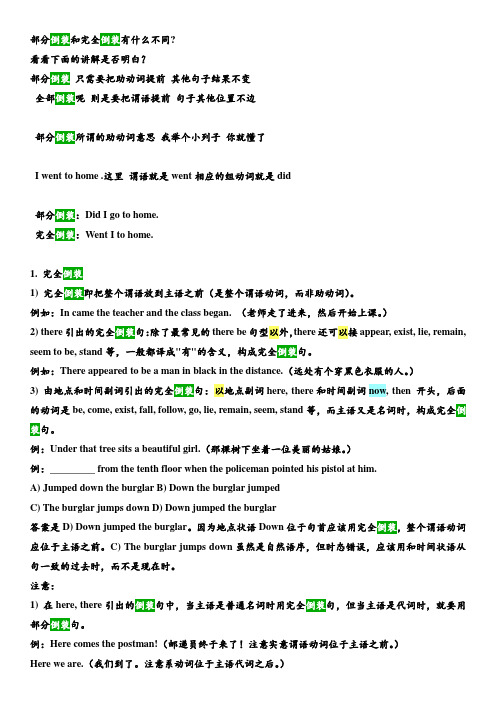
部分和完全有什么不同?看看下面的讲解是否明白?部分只需要把助动词提前其他句子结果不变全部呢则是要把谓语提前句子其他位置不边部分所谓的助动词意思我举个小列子你就懂了I went to home .这里谓语就是went相应的组动词就是did部分:Did I go to home.完全:Went I to home.1. 完全1) 完全即把整个谓语放到主语之前(是整个谓语动词,而非助动词)。
例如:In came the teacher and the class began. (老师走了进来,然后开始上课。
)2) there引出的完全句:除了最常见的there be句型以外,there还可以接appear, exist, lie, remain, seem to be, stand等,一般都译成"有"的含义,构成完全句。
例如:There appeared to be a man in black in the distance.(远处有个穿黑色衣服的人。
)3) 由地点和时间副词引出的完全句:以地点副词here, there和时间副词now, then 开头,后面的动词是be, come, exist, fall, follow, go, lie, remain, seem, stand等,而主语又是名词时,构成完全句。
例:Under that tree sits a beautiful girl.(那棵树下坐着一位美丽的姑娘。
)例:_________ from the tenth floor when the policeman pointed his pistol at him.A) Jumped down the burglar B) Down the burglar jumpedC) The burglar jumps down D) Down jumped the burglar答案是D) Down jumped the burglar。
英语倒装句的几种情况

英语倒装句的几种情况按“主语+ 谓语” 这种顺序排列的句子是陈述语序。
如果排列顺序变为“谓语(或谓语一部分)+主语”,就是倒装。
倒装句分为:完全倒装:整个谓语移至主语前面叫完全倒装。
部分倒装:只把助动词、系动词或情态动词放在主语之前叫部分倒装。
一.完全倒装1. There be + 主语+地点。
另外,在此结构中可以用来代替be动词的动词有:exist, seem, happen, appear, rise, stand等。
如:There stood a dog before him.There are many different kinds of mooncakes on the table .2.Here, There, Now, Then + come (或be等) + 主语" 结构。
主语是人称代词时,不必倒装。
There是引导词,本身没意义。
There comes the bus.Then came the day we are looking forward to.**Here you are! There they come!**3. 表示方位的副词或短语out, in, up, down,away放在句首,后面一般使用倒装语序。
这种句子的为主动词通常为go, come, rush, fly ,fall.. 主语是人称代词时,不必倒装。
In came our teacher.4. 表示地点的介词短语(如on the wall, under the tree, in front of the house, in the middle of the room等)放在句首时,要全部倒装。
如:On the top of the hill stands a pine tree.In front of the classroom is a playground.5. 如果直接引语后注明是什么人说的,而且主语是名词时,需要完全倒装;主语是人称代词时,一般不用倒装。
英语句型全倒装和半倒装
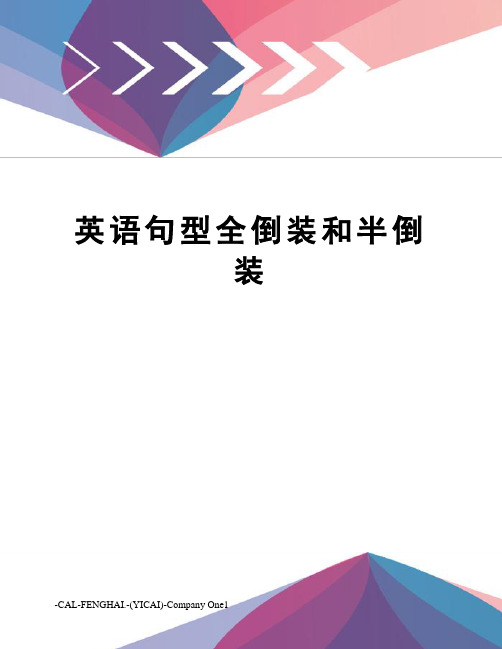
英语句型全倒装和半倒装-CAL-FENGHAI.-(YICAI)-Company One1全倒装和半倒装1. 完全倒装1) 完全倒装即把整个谓语放到主语之前(是整个谓语动词,而非助动词)。
例如:In came the teacher and the class began. (老师走了进来,然后开始上课。
) (这类词通常有:away in out up)2) there引出的完全倒装句:除了最常见的there be句型以外,there还可以接appear, exist, lie, remain, seem to be, stand等,一般都译成"有"的含义,构成完全倒装句。
例如:There appeared to be a man in black in the distance.(远处有个穿黑色衣服的人。
)3) 由地点和时间副词引出的完全倒装句:以地点副词here, there和时间副词now, then 开头,后面的动词是be, come, exist, fall, follow, go, lie, remain, seem, stand等,而主语又是名词时,构成完全倒装句。
例:Under that tree sits a beautiful girl.(那棵树下坐着一位美丽的姑娘。
)例:_________ from the tenth floor when the policeman pointed his pistol at him.A) Jumped down the burglar B) Down the burglar jumpedC) The burglar jumps down D) Down jumped the burglar答案是D) Down jumped the burglar。
因为地点状语Down位于句首应该用完全倒装,整个谓语动词应位于主语之前。
部分倒装和完全倒装的区别

部分倒装和完全倒装的区别倒装句是将正常的陈述语序加以变化,主要作用是强调被提前的部分,分为两种:一、全部倒装:谓语动词提前至主语之前;二、部分倒装:助动词或情态动词提至主语之前,谓语动词位置不变。
扩展资料英语当中的倒装是一个非常重要的知识点,我们一定要看一下,倒装句型分成两类:部分倒装和完全倒装。
顾名思义,所谓部分倒装指的是谓语的一部分,跑到了主语的前面,部分倒装过来了,那主要的部分,也就是谓语主要的部分,还是在主语之后。
我们举个例子。
Only in this way can we learn English well. 只有用这种方法,我们能把英语学好。
Only in this way,当我们要强调这个状语的时候,Only in this way,我会用到部分倒装,can we learn English well. 大家注意看一下,can we learn 主语是we,learn是谓语。
跑到了后面。
它前面是一个助动词,can we learn,也就是说谓语的一部分跑到了主语之前,主要的谓语还是在后边的,所以我们把这个叫做部分倒装。
再过一遍这个例句。
Only in this way can we learn English well.接下来完全倒装那就更好理解了。
那就是完全的,整个谓语跑到主语之前。
比如说 In this classroom sits a student.学生坐在教室里,但是这里我要强调往前放的部分,也就是in the classroom。
然后我再说谓语叫做sits,然后再是主语 student。
好,这句话正常的顺序谁都知道叫做A student sits in the classroom。
而我这个时候用完全倒装。
Student作为主语,sits作为谓语,完全发生了顺序的颠倒,我们就叫完全倒装。
不管怎么样,部分倒装、完全倒装,它们的功能是一样的,是为了强调,强调往前放的部分。
倒装(全部倒装和部分倒装)

倒装(全部倒装和部分倒装 倒装 全部倒装和部分倒装) 全部倒装和部分倒装
1.全部倒装(Full Inversion), 又称主谓倒装 (Subject-verb Inversion)。 例如: Here are some letters for you. Down poured the rain. Into the coach scrambled the children. 2.部分倒装(Partial Inversion), 又称主语与助动词/晴态 动词倒装(Subject-operator Inversion)。 例如:Never have I heard such nonsense. Only today did I learn the dreadful news. .
部分倒装句的具体用法
6.在比较和方式状语从句中,如果主语不是人称代词,
常在主语前加助动词 do / did 代替前面已出现过的动词。 例如:I spend more than do my friends. She traveled a great deal as did most of her friends.
全部倒装句的具体用法
3.为了使描写的景象更生动,常把拟声词或away, in, out, up 等状语放在句首,从而引起主谓全部倒装。 例如:Down it fell from the apple tree. The door opened. In rushed the crowd.
全部倒装句的具体用法
全部倒装句的具体用法
5.用于表示祝愿的句型。 例如:May you live a long and happy life ! Long live the People’s Republic of China !
英语部分倒装与完全倒装的区别

英语部分倒装与完全倒装的区别很多同学都学习过英语倒装句,那么部分倒装与完全倒装有什么不同之处?部分倒装与完全倒装的不同完全倒装:完全倒装即把整个谓语放到主语之前(是整个谓语动词,而非助动词)。
部分倒装:部分倒装即只把谓语的一部分(如助动词、情态动词等)放到主语前,或把句子的强调成分提前。
部分倒装与全部倒装的区别在于用法。
完全倒装表示地点、时间或方位的副词或介词短语(here, there, now, then, up, down, away, off, in, out, in the room, on the wall等)置于句首,且主语为名词时。
完全倒装的时态常用一般现在时或一般过去时,不用进行时。
所以如果你遇见地点状语提前,但是没有完全倒装的时候,看看是不是时态的问题造成了这种不倒装的情形。
部分倒装1.含有否定意义的副词或介词短语(never, seldom, little, hardly, by no means, at no time等)位于句首时。
2.only修饰介词短语、副词或状语从句,且置于句首时。
3.so/neither+助动词/be动词/情态动词+主语,意为“……也是如此/……也不”。
4.hardly...when, no sooner...than, not only...but(also)等引导两个分句时,若hardly, no sooner, not only位于句首,前一个分句用部分倒装,后一个分句不变。
5.not until...置于句首时,主句需部分倒装。
6.so...that...和such...that...句式中,so或such及其所修饰的成分置于句首时,主句需部分倒装。
7.though/as引导让步状语从句时通常用倒装结构,其结构为:名词/形容词/副词/动词+though/as+主谓结构。
8.当if引导的虚拟条件从句中含有had,were或should等时,如将if省略,则要将had,were或should提到主语之前。
英语完全倒装和部分倒装--解决不易懂
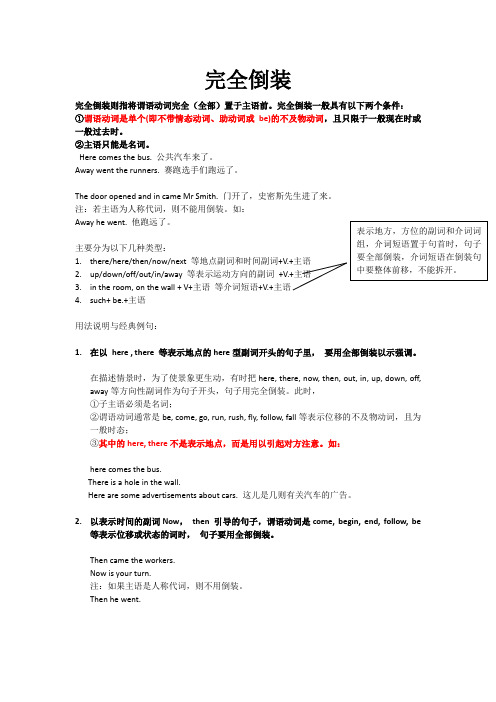
完全倒装完全倒装则指将谓语动词完全(全部)置于主语前。
完全倒装一般具有以下两个条件:①谓语动词是单个(即不带情态动词、助动词或be)的不及物动词,且只限于一般现在时或一般过去时。
②主语只能是名词。
Here comes the bus. 公共汽车来了。
Away went the runners. 赛跑选手们跑远了。
The door opened and in came Mr Smith. 门开了,史密斯先生进了来。
注:若主语为人称代词,则不能用倒装。
如:Away he went. 他跑远了。
主要分为以下几种类型:1.there/here/then/now/next 等地点副词和时间副词+V.+主语2.up/down/off/out/in/away 等表示运动方向的副词+V.+主语3.in the room, on the wall + V+主语等介词短语+V.+主语4.such+ be.+主语用法说明与经典例句:1.在以here , there 等表示地点的here型副词开头的句子里,要用全部倒装以示强调。
在描述情景时,为了使景象更生动,有时把here, there, now, then, out, in, up, down, off, away等方向性副词作为句子开头,句子用完全倒装。
此时,①子主语必须是名词;②谓语动词通常是be, come, go, run, rush, fly, follow, fall等表示位移的不及物动词,且为一般时态;③其中的here, there不是表示地点,而是用以引起对方注意。
如:here comes the bus.There is a hole in the wall.Here are some advertisements about cars. 这儿是几则有关汽车的广告。
2.以表示时间的副词Now,then 引导的句子,谓语动词是come, begin, end, follow, be等表示位移或状态的词时,句子要用全部倒装。
部分倒装与完全倒装的区别
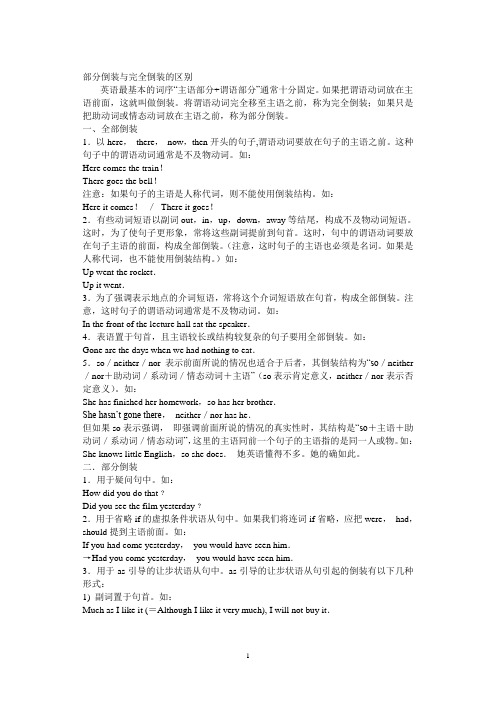
部分倒装与完全倒装的区别英语最基本的词序“主语部分+谓语部分”通常十分固定。
如果把谓语动词放在主语前面,这就叫做倒装。
将谓语动词完全移至主语之前,称为完全倒装;如果只是把助动词或情态动词放在主语之前,称为部分倒装。
一、全部倒装1.以here,there,now,then开头的句子,谓语动词要放在句子的主语之前。
这种句子中的谓语动词通常是不及物动词。
如:Here comes the train!There goes the bell!注意:如果句子的主语是人称代词,则不能使用倒装结构。
如:Here it comes!/There it goes!2.有些动词短语以副词out,in,up,down,away等结尾,构成不及物动词短语。
这时,为了使句子更形象,常将这些副词提前到句首。
这时,句中的谓语动词要放在句子主语的前面,构成全部倒装。
(注意,这时句子的主语也必须是名词。
如果是人称代词,也不能使用倒装结构。
)如:Up went the rocket.Up it went.3.为了强调表示地点的介词短语,常将这个介词短语放在句首,构成全部倒装。
注意,这时句子的谓语动词通常是不及物动词。
如:In the front of the lecture hall sat the speaker.4.表语置于句首,且主语较长或结构较复杂的句子要用全部倒装。
如:Gone are the days when we had nothing to eat.5.so/neither/nor表示前面所说的情况也适合于后者,其倒装结构为“so/neither /nor+助动词/系动词/情态动词+主语”(so表示肯定意义,neither/nor表示否定意义)。
如:She has finished her homework,so has her brother.She hasn’t gone there,neither/nor has he.但如果so表示强调,即强调前面所说的情况的真实性时,其结构是“so+主语+助动词/系动词/情态动词”,这里的主语同前一个句子的主语指的是同一人或物。
there的倒装句
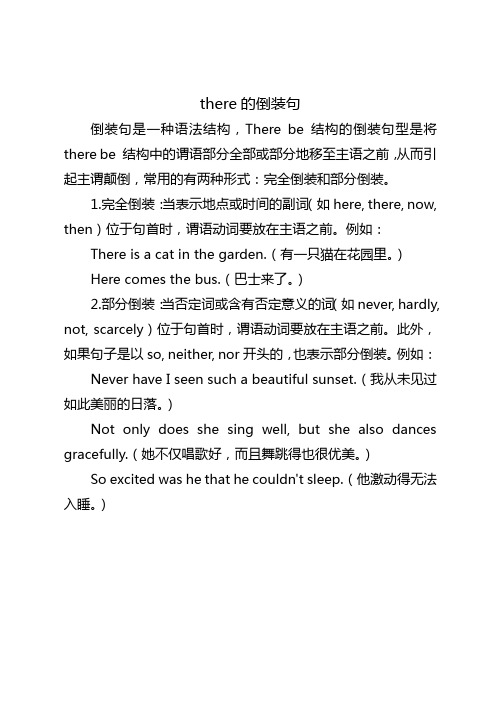
there的倒装句
倒装句是一种语法结构,There be 结构的倒装句型是将there be 结构中的谓语部分全部或部分地移至主语之前,从而引起主谓颠倒,常用的有两种形式:完全倒装和部分倒装。
1.完全倒装:当表示地点或时间的副词(如here, there, now, then)位于句首时,谓语动词要放在主语之前。
例如:There is a cat in the garden.(有一只猫在花园里。
)
Here comes the bus.(巴士来了。
)
2.部分倒装:当否定词或含有否定意义的词(如never, hardly, not, scarcely)位于句首时,谓语动词要放在主语之前。
此外,如果句子是以so, neither, nor开头的,也表示部分倒装。
例如:Never have I seen such a beautiful sunset.(我从未见过如此美丽的日落。
)
Not only does she sing well, but she also dances gracefully.(她不仅唱歌好,而且舞跳得也很优美。
)
So excited was he that he couldn't sleep.(他激动得无法入睡。
)。
英语语法解读部分倒装与完全倒装
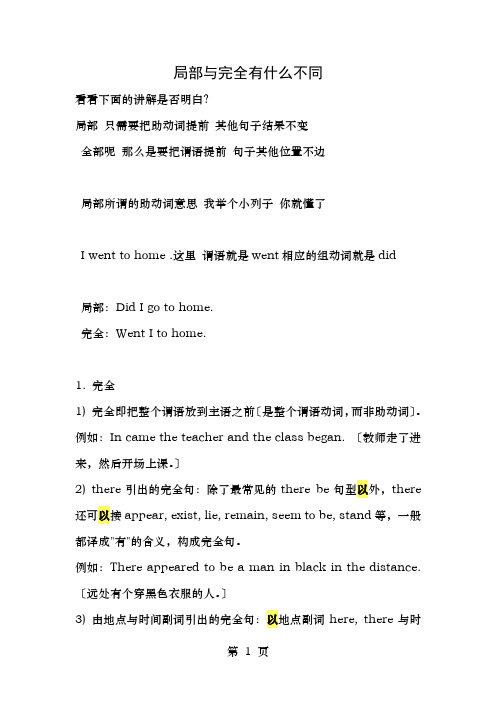
局部与完全有什么不同看看下面的讲解是否明白?局部只需要把助动词提前其他句子结果不变全部呢那么是要把谓语提前句子其他位置不边局部所谓的助动词意思我举个小列子你就懂了I went to home .这里谓语就是went相应的组动词就是did局部:Did I go to home.完全:Went I to home.1. 完全1) 完全即把整个谓语放到主语之前〔是整个谓语动词,而非助动词〕。
例如:In came the teacher and the class began. 〔教师走了进来,然后开场上课。
〕2) there引出的完全句:除了最常见的there be句型以外,there 还可以接appear, exist, lie, remain, seem to be, stand等,一般都译成"有"的含义,构成完全句。
例如:There appeared to be a man in black in the distance.〔远处有个穿黑色衣服的人。
〕3) 由地点与时间副词引出的完全句:以地点副词here, there与时间副词now, then 开头,后面的动词是be, come, exist, fall, follow, go, lie, remain, seem, stand等,而主语又是名词时,构成完全句。
例:Under that tree sits a beautiful girl.〔那棵树下坐着一位美丽的姑娘。
〕例:_________ from the tenth floor when the policeman pointed his pistol at him.A) Jumped down the burglar B) Down the burglar jumped C) The burglar jumps down D) Down jumped the burglar答案是D) Down jumped the burglar。
- 1、下载文档前请自行甄别文档内容的完整性,平台不提供额外的编辑、内容补充、找答案等附加服务。
- 2、"仅部分预览"的文档,不可在线预览部分如存在完整性等问题,可反馈申请退款(可完整预览的文档不适用该条件!)。
- 3、如文档侵犯您的权益,请联系客服反馈,我们会尽快为您处理(人工客服工作时间:9:00-18:30)。
部分倒装与完全倒装的区别英语最基本的词序“主语部分+谓语部分”通常十分固定。
如果把谓语动词放在主语前面,这就叫做倒装。
将谓语动词完全移至主语之前,称为完全倒装;如果只是把助动词或情态动词放在主语之前,称为部分倒装。
一、全部倒装1.以here,there,now,then开头的句子,谓语动词要放在句子的主语之前。
这种句子中的谓语动词通常是不及物动词。
如:Here comes the train!There goes the bell!注意:如果句子的主语是人称代词,则不能使用倒装结构。
如:Here it comes!/There it goes!2.有些动词短语以副词out,in,up,down,away等结尾,构成不及物动词短语。
这时,为了使句子更形象,常将这些副词提前到句首。
这时,句中的谓语动词要放在句子主语的前面,构成全部倒装。
(注意,这时句子的主语也必须是名词。
如果是人称代词,也不能使用倒装结构。
)如:Up went the rocket.Up it went.3.为了强调表示地点的介词短语,常将这个介词短语放在句首,构成全部倒装。
注意,这时句子的谓语动词通常是不及物动词。
如:In the front of the lecture hall sat the speaker.4.表语置于句首,且主语较长或结构较复杂的句子要用全部倒装。
如:Gone are the days when we had nothing to eat.5.so/neither/nor表示前面所说的情况也适合于后者,其倒装结构为“so/neither /nor+助动词/系动词/情态动词+主语”(so表示肯定意义,neither/nor表示否定意义)。
如:She has finished her homework,so has her brother.She hasn’t gone there,neither/nor has he.但如果so表示强调,即强调前面所说的情况的真实性时,其结构是“so+主语+助动词/系动词/情态动词”,这里的主语同前一个句子的主语指的是同一人或物。
如:She knows little English,so she does.她英语懂得不多。
她的确如此。
二.部分倒装1.用于疑问句中。
如:How did you do that﹖Did you see the film yesterday﹖2.用于省略if的虚拟条件状语从句中。
如果我们将连词if省略,应把were,had,should提到主语前面。
如:If you had come yesterday,you would have seen him.→Had you come yesterday,you would have seen him.3.用于as引导的让步状语从句中。
as引导的让步状语从句引起的倒装有以下几种形式:1) 副词置于句首。
如:Much as I like it (=Although I like it very much), I will not buy it.2) 动词原形置于句首。
如Wait as you may(=Although you may wait), he will not see you.3) 形容词或名词置于句首。
如:Proud as the nobles are (=Although the nobles are proud), they are afraid to see me.Child as he is (=Although he is a child), he can tell right from wrong.注意:如果名词前有形容词修饰时,as 引导的倒装句中要保留不定冠词。
如:A bad-tempered man as he is (=Although he is a bad-tempered man), he loves me deeply.4.具有否定意义的副词或连词(not,hardly,no sooner, not until, seldom,not once,at no time,never,little等) 置于句首时,句子(主句)采用部分倒装。
如:Little do we know about him.No sooner had he closed his eyes than he fell asleep.Seldom does he come back on Sundays.Not until he came back did I know about it.5.only修饰句子的状语(从句)位于句首时,句子(主句)要用部分倒装。
如:Only then did I realize the importance of English.但如果only修饰的是句子的其它成分,则无需倒装。
如:Only socialism can save China.(only修饰的是句子的主语,故仍用正常语序。
)6.not only…but also… 连接两个并列分句时,第一个分句应使用部分倒装。
如:Not only does he do well in his lessons, but also he often helps others with their lessons.7.so…that结构中的倒装。
有时要强调so所修饰的形容词或副词,常将so连同它所修饰的形容词或副词一起提到句首。
这时,主句要用倒装结构。
如:He runs so fast that he is far ahead of others.→So fast does he run that he is far ahead of others.He is so clever that he can work out all the difficult problems in the book.→So clever is he that he can work out all the difficult problems in the book.(全部倒装)倒装的原因有二:1)由于一定语法结构的需要,如:Have you known Mr. Davis long?你认识戴维斯先生很久了吗?Where have you been?你刚才到哪里去了?Was the car damaged by a truck?这辆小轿车是让大卡车给撞坏的吗?2)由于强调,如:Never have I heard such a funny story.我从来没听过这样有趣的故事。
Only then did I fully understand what my father said.只有到那时,我才充分理解我父亲讲的话。
倒装结构的基本用法在下列情况下,通常用倒装句。
.1)在问句中,如:What does your father do?你父亲干什幺工作?How are you?你身体好吗?Is he singing of is his brother?是他在唱,还是他弟弟在唱?Was your school setup in 1958? 你们的学校是7958年成立的吗?2)在“there + be”结构里,如:There are many tall buildings in Hong Kong.香港有很多高建筑物。
There is a plane at the airport.飞机场上有一架飞机。
There are different forms of energy.有各种不同形式的能量。
3)在以here(这里),there(那里)等副词开头的某些句子里(须用现在一般时),如:There goes our director.我们的主任走了。
There goes then bell.铃响了。
Here is a ticket for you.这儿有张票给你。
Here comes the bus.公共汽车来了。
[注]但如果主语是人称代词,主语和谓语动词的词序则不变。
如:There he comes.他来了。
Here it is.在这儿(或这就是)。
4)虚拟结构中的条件从句省去it时这时were,had和should须移至主语之前。
如:He would do more work were he in your place.如果他是你的话,他会干更多工作。
Should I earn more money,I should live better.如果我能赚更多的钱,我会生活得好些。
You would have done well had you taken her advice.你如果听她的意见,你就会干得好些。
Were there no steel,there would be no modern industry.没有钢就不会有现代工业。
5)直接宾语如果是直接引语的全部或一部分往往放在句首,这时主语和谓语动词也可颠倒位置。
如:“You all made great progress last term,”said the teacher.老师说:“你们上学期都取得了很大的进步。
”“Miss smith,”replied the monitor,“our success is inseparable from your hard work.”“史密斯小姐,”班长回答说,“我们的成绩与你的辛勤劳动是分不开的。
”6)在某些表达祝愿的句子里,如:Long live the people!人民万岁!May you all be happy!祝你们大家愉快!7)在用肋表示“我也这样”一类概念的结构里,其公式是:肯定:so + be,have,助动词或情态动词+ 主语否定:neither (nor) + be,have,助动词或情态动词+ 主语He has visited the museum. -so have I.他参观了博物馆。
——我也参观了。
She enjoys literature.-so does every one of us.他喜欢文学——我们每个人也都喜欢。
They can play chess. -so can we.他们会下棋。
——我们也会。
He is a basketball fan. -so do I.他是一个篮球迷。
——我也是。
H e isn’t a businessman. -neither am I.他不是商人——我也不是。
They were not thirsty. -nor were we.他们不渴——我们也不渴。
